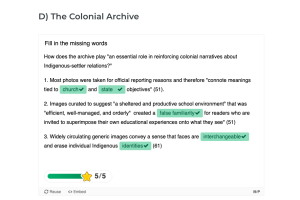When Waneek Horn-Miller says the government is “trying but still approaching Indigenous sport development in a very colonial way,” she means that while there may be good intentions, the efforts are still being led and shaped by settler institutions. Instead of empowering Indigenous communities to decide what sport means to them, the government imposes Western ideas of structure, competition, and success—repeating the same patterns of control and cultural dominance seen in the past.
4
These are difficult stories. We bear witness in this chapter to the role of sport in furthering the settler colonial projects throughout Turtle Island. Here are some supports to access in the community and from a distance:
First Peoples House of Learning Cultural Support & Counselling
Niijkiwendidaa Anishnaabekwag Services Circle (Counselling & Healing Services for Indigenous Women & their Families) – 1-800-663-2696
Nogojiwanong Friendship Centre (705) 775-0387
Peterborough Community Counselling Resource Centre: (705) 742-4258
Hope for Wellness – Indigenous help line (online chat also available) – 1-855-242-3310
LGBT Youthline: askus@youthline.ca or text (647)694-4275
National Indian Residential School Crisis Line – 1-866-925-4419
Talk4Healing (a culturally-grounded helpline for Indigenous women):1-855-5544-HEAL
Section One: History
A) The Residential School System
Exercise 1: Notebook Prompt
We are asked to honour these stories with open hearts and open minds.
Which part of the chapter stood out to you? What were your feelings as you read it? (50 words)
| What stood out to me was how sports was used to erase cultural identities rather than empower them. I’d always thought of sports as beneficial, but reading about how they’ve replaced Indigenous traditions made me uneasy and sad. It questioned my previous understanding of the role of sports in history.
|
B) Keywords
Exercise 2: Notebook Prompt
Briefly define (point form is fine) one of the keywords in the padlet (may be one that you added yourself).
| Keyword: Cultural Genocide.
A group’s cultural practices, languages, and identities are deliberately and systematically destroyed.
|
C) Settler Colonialism
Exercise 3: Complete the Activities

Exercise 4: Notebook Prompt
Although we have discussed in this module how the colonial project sought to suppress Indigenous cultures, it is important to note that it also appropriates and adapts Indigenous cultures and “body movement practices” (75) as part of a larger endeavour to “make settlers Indigenous” (75).
What does this look like? (write 2 or 3 sentences)
| It looks like settlers adopting Indigenous symbols and traditions in ways that erase their original meaning. This helps settlers to feel connected to the land while neglecting the identities and histories of Indigenous peoples.
|
D) The Colonial Archive

Exercise 5: Complete the Activities
Section Two: Reconciliation
A) Reconciliation?
Exercise 6: Activity and Notebook Prompt
Visit the story called “The Skate” for an in-depth exploration of sport in the residential school system. At the bottom of the page you will see four questions to which you may respond by tweet, facebook message, or email:
How much freedom did you have to play as a child?
What values do we learn from different sports and games?
When residential staff took photos, what impression did they try to create?
Answer one of these questions (drawing on what you have learned in section one of this module or prior reading) and record it in your Notebook.
| When residential staff took photos, what impression did they try to create?
Residential staff often took photographs to provide the idea that the schools were safe, happy, and productive. These edited photographs were intended to show joyful kids participating in sports or school activities, but they hid the brutal reality of abuse, neglect, and cultural erasure. The photographs strengthened a narrative that the schools were assisting Indigenous children, when in fact they were part of a colonial system designed for assimilation.
|
B) Redefining Sport
B) Sport as Medicine
Exercise 7: Notebook Prompt
Make note of the many ways sport is considered medicine by the people interviewed in this video.
|
C) Sport For development
Exercise 7: Notebook Prompt
What does Waneek Horn-Miller mean when she says that the government is “trying but still approaching Indigenous sport development in a very colonial way”?
|
|
Exercise 8: Padlet Prompt
Add an image or brief comment reflecting some of “binding cultural symbols that constitute Canadian hockey discourse in Canada.” Record your responses in your Notebook as well.
| The maple leaf on Team Canada jerseys is one of the significant cultural icons in Canadian hockey. It symbolizes national pride and solidarity, but it also hides the persistent discrimination and obstacles to progress that Indigenous players and communities experience in the sport. The narrative of “hockey as Canada’s game” frequently misses those whose tales are left out.
|
Section Three: Decolonization
Please see the major assignment for this half of the term in the final section of this chapter.

